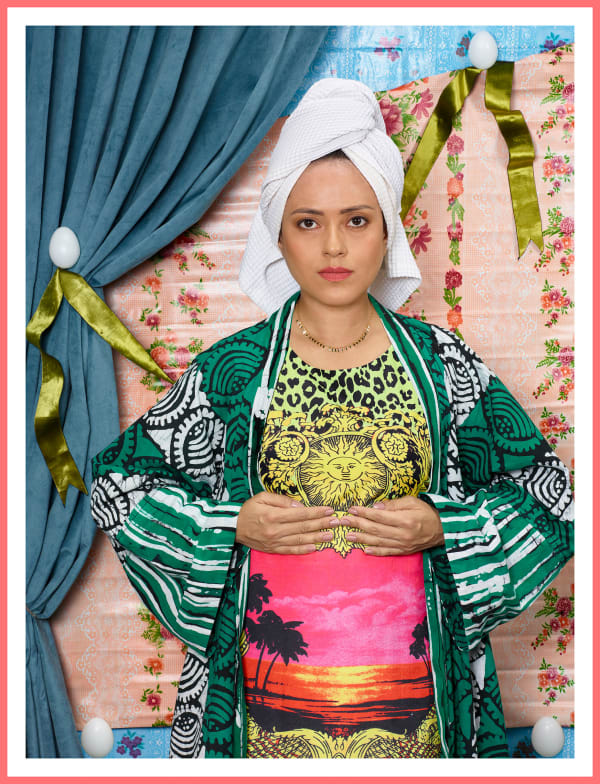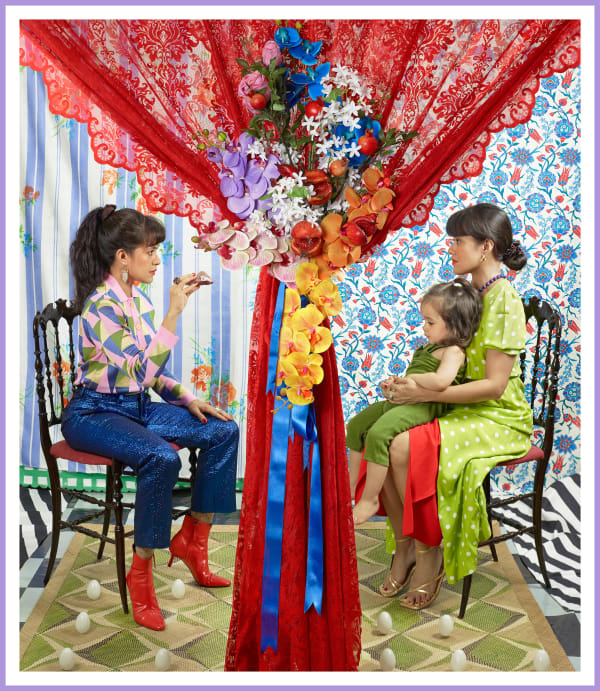-
Wawi Navarroza
As Wild As We Come -

-
-
Solo exhibitions include (Upcoming) As Wild As We Come, Kristin Hjellegjerde Gallery, London, England (2022); Self-Portraits & The Tropical Gothic, Silverlens Galleries, Manila (2019); Medusa, Silverlens Galleries, Manila (2017); On Landscape & Some Dislocations, Galería Patrick Domken, Cadaqués, Spain (2012); When All Is Said And Done, Artesan Gallery, Singapore (2008); Saturnine: A Collection of Portraits, Creatures, Glass & Shadow, Silverlens, Manila / McDermott Gallery, Siem Reap, Cambodia / ArtReflex Gallery, Saint-Petersburg, Russia (2007); Polysaccharide: The Dollhouse Drama, Blacksoup Project Artspace, Manila / Ateneo Art Gallery, Manila / La Trobe University, Bendigo, Australia (2005).Selected group exhibitions include Run with Wolves, Lawrie Shabibi gallery, Dubai (2021); Tonight The Air Is Warm, Kristin Hjellegjerde Gallery, London (2021); SF Camerawork, San Francisco (2021); Viva La Frida!, Drents Museum, Netherlands (2021); Anticipating the Day, Silverlens, Manila (2020); Taboo, Vinyl on Vinyl, Makati (2019); Not Visual Noise: Philippine Photography, Ateneo Art Gallery at Areté, Quezon City (2019); ART|JOG|11 Enlightenment, Yogyakarta National Museum, Jogjakarta, Indonesia (2018); Artists’ Books for Everything, Weserburg Museum of Modern Art, Bremen, Germany (2017); Roundabout: Wawi Navarroza, Mark Valenzuela, Riel Hilario, Adelaide Central Gallery, Australia (2016); Surface Tension: Perspective on the Changing Landscape, Alliance Française de Manille for COP:21 Paris (2015); Still Moving: After Image, South-East Asian contemporary photography survey show, Singapore Art Museum 8Q, Singapore (2014) and The Hope & The Dream in Filipino: Contemporary Photography from the Philippines, The Month of Photography Tokyo 2012, presented by The Photographic Society of Japan and Tokyo Museum of Photography, Tokyo, Japan (2012).
-
Highlights and collections She has exhibited widely in the Philippines and internationally, including the National Museum of the Philippines, Metropolitan Museum of Manila, National Gallery of Singapore (upcoming 2022), Singapore Art Museum 8Q, Hangaram Museum (Korea), National Museum of Fine Arts (Taiwan), Yogyakarta National Museum (Indonesia), Fries Museum of Contemporary Art & Museum Belvedere (Netherlands), Danubiana Museum (Slovakia), and in galleries in Australia, Japan, Malaysia, Singapore, Laos, Cambodia, London, Spain, Italy, and Russia; with continued participation in international photography festivals and art fairs such as Art Basel HK. Her art has been surveyed in books such as “Photography Today” (Phaidon), “Contemporary Photography in Asia” (Prestel) and “Photography in South East Asia” by Zuang Wubin (NUS Press).
-
-

-
-
Born in Manila in the Philippines, Navarroza’s practice is rooted in a deep, embodied sense of place that is best understood through the lens of ‘Tropical Gothic’ – a term coined by Filipino national artist Nick Joaquin. Navarroza describes the Tropical Gothic as a fitting portrait of Filipino culture that is a syncretic blend of the local with a heady mix of Spanish Catholic and American Pop while remaining distinctly South East Asian. In terms of her own art, it provides a useful framework, or as she describes it, ‘a container for everything that I can’t exactly define – all of the things that I’ve been observing, living, breathing from childhood until now.’ Her photographic works employ a process of in-studio collage in order to examine and disentangle this process of synthesis from both a very personal perspective and in relation to reductive stereotypes surrounding the Orient. Navarroza notes, for example, that the term ‘wild’ has often been used in association with the Orient to describe something unknown, dangerous or savage, but here, in the title of the exhibition, she reclaims the word as an expression of defiance, knowing, vitality and play.This latest body of work marks a particularly transformational period for the artist in which she has become a mother and moved across the globe from Manila to Istanbul, a country which sits on the cusp of Asia and Europe, the ancient and modern world. Though both experiences were destabilising in different ways, the artist chooses to reflect on how they have enriched her perspectives of the world and renewed her connection to both her body and art. There is a distinct celebratory atmosphere throughout: in the riotous melding of colour, pattern and texture that – an aesthetic that recalls the artist’s memories of fiestas in Manila – and in the depiction of birthday cakes, in a trio of still life works, that refer to the birth of Navarroza’s child but also her own rebirth as a mother.
-
Among the most visceral of the self-portraits is a work titled Vagus (after the longest nerve of the autonomic nervous system in the human body). Here, a river of red, lacy fabric runs from the top of the image to pool around Navarroza's feet, evoking the appearance of blood, which as the artist notes, is ‘both universally life-giving and intensely personal.’ The artist appears seated on a bed with her legs open, a black wire extending from her stomach in a gesture to an umbilical cord and a collection of carnelian crystals at her feet. The stones make reference to the notion of healing and balance as well as continuity to planetary time, while the artist’s pose, with her arm bent up around her head, mimics an exercise to relieve the vagus nerve system and reduce stress. In one sense, this is a portrait of vulnerability and exposure, inviting an intimate encounter between viewer and artist as Navarroza translates the private experience of childbirth and motherhood into tangible materials, but at the same time, she draws our attention to the artifice. A striped curtain on the left-hand side recalls the structure of a stage while the strip of yellow floral wallpaper behind the bed is loosely hung over a painted green grid.Elsewhere, the artist’s orchestration of the image is made visible through visual anomalies. In the work titled The Shopper, for example, the background is composed of different checkered patterns containing glitches where the grid overlaps or repeats itself. Navarroza, who also appears dressed in checkered clothing, stands in front of a roughly cut-out shape of a blue and white vase as if she, herself, is contained. As in many of the works, Navarroza brings together the contemporary with the ancient, the banal with the spiritual. There is a shopping bag filled with potatoes flung over her shoulder while she holds an artichoke heart with open palms in front of her chest, imitating a gesture of prayer. Meanwhile, a small rectangle of woven polychromatic, upcycled fabric, that’s commonly used in the Philippines as a doormat, forms a halo behind her head. It is this slippage of meaning that makes the works so compelling; each time we return to the image, we are able to unlock new layers of symbolism and construct our own narratives afresh. In this way, Navarroza enacts her own kind of resistance. Her bright, joyous collaged scenes rally against notions of seamlessness and stability in favour of hybridity, creative curiosity and transformation.
-
-
 These tableaus brim with symbolism and allegory, but there is also, lastly, a Wildness in their aesthetic of excess. Navarroza’s zealous use of colour, pattern, and texture – in addition to the plethora of objects and gestures – as seen in the backdrop of The Shopper / Heart Sutra (Self-Portrait with Artichoke) result in an amalgamation of overwhelming visual and cognitive stimuli that articulate as Postcolonial Camp. The ‘Postcolonial’ preface highlights the necessity of postcolonial agency in engaging with this notion as a method of subversion following over 500 years of subjugation by Spain, America and Japan; ‘Camp’, as described by Susan Sontag in her pioneering text ‘Notes on Camp’, is the victory of style, aesthetics, and irony over content, morality, and tragedy. The artist has admitted to shying away from descriptors such as Kitsch or Camp in the past, preferring instead serious and plainly conceptual modes. However, her realisation of these opinions’ colonial and patriarchal inheritance unlocked her current practice full of vivacity and theatricality, which is no less critically engaged. Countries of the Global South such as the Philippines that have acceded a kitsch mode are particularly susceptible to derogatory condescension regarding taste. Though, capitalist forces of the Global North such as that which precipitated the widespread Filipino migration movement – that Navarroza is a participant of – and Oversees Foreign Worker (OFW) phenomenon are largely responsible for the same aesthetic it derides. These Filipinos often bring back indexes of the cultures in which they found success such as curtain swags or Roman columns that might be called unsophisticated, but in reality reflect a perseverance and resourcefulness that should be celebrated. The Postcolonial Camp thus emerges within contemporary Philippines and Navarroza’s tableaus as an alternative reality filled with creativity, playfulness and substance.This series’ title As Wild As They Come indicate Navarroza’s intention of maximising the Wild signifier. She has indeed accomplished this, as these photographs brim with a visual lexicon that undermines conventional and destructive meanings of the Other, nature, women, and excess. The artist’s tableaus celebrate what we’ve been conditioned to be ashamed about, embracing the chaos in a cathartic act of joy, play, and sensorial delight.
These tableaus brim with symbolism and allegory, but there is also, lastly, a Wildness in their aesthetic of excess. Navarroza’s zealous use of colour, pattern, and texture – in addition to the plethora of objects and gestures – as seen in the backdrop of The Shopper / Heart Sutra (Self-Portrait with Artichoke) result in an amalgamation of overwhelming visual and cognitive stimuli that articulate as Postcolonial Camp. The ‘Postcolonial’ preface highlights the necessity of postcolonial agency in engaging with this notion as a method of subversion following over 500 years of subjugation by Spain, America and Japan; ‘Camp’, as described by Susan Sontag in her pioneering text ‘Notes on Camp’, is the victory of style, aesthetics, and irony over content, morality, and tragedy. The artist has admitted to shying away from descriptors such as Kitsch or Camp in the past, preferring instead serious and plainly conceptual modes. However, her realisation of these opinions’ colonial and patriarchal inheritance unlocked her current practice full of vivacity and theatricality, which is no less critically engaged. Countries of the Global South such as the Philippines that have acceded a kitsch mode are particularly susceptible to derogatory condescension regarding taste. Though, capitalist forces of the Global North such as that which precipitated the widespread Filipino migration movement – that Navarroza is a participant of – and Oversees Foreign Worker (OFW) phenomenon are largely responsible for the same aesthetic it derides. These Filipinos often bring back indexes of the cultures in which they found success such as curtain swags or Roman columns that might be called unsophisticated, but in reality reflect a perseverance and resourcefulness that should be celebrated. The Postcolonial Camp thus emerges within contemporary Philippines and Navarroza’s tableaus as an alternative reality filled with creativity, playfulness and substance.This series’ title As Wild As They Come indicate Navarroza’s intention of maximising the Wild signifier. She has indeed accomplished this, as these photographs brim with a visual lexicon that undermines conventional and destructive meanings of the Other, nature, women, and excess. The artist’s tableaus celebrate what we’ve been conditioned to be ashamed about, embracing the chaos in a cathartic act of joy, play, and sensorial delight. -
Enquire
-
As Wild As We Come : Wawi Navarroza
Past viewing_room













